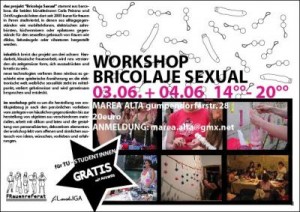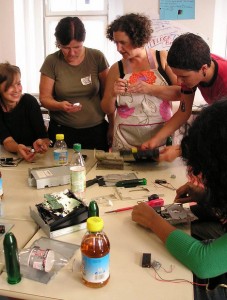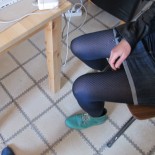Art, Technology and Desire “Sexual Bricolaje” Group (Sexual DIY)
Approaches on feminism, art and technology; Sexual Bricolage as Case of Study
This paper originally emerged from a research on Women, Art & Technology in Barcelona, that we organized in 2009 with Vanina Hofman. The project’s aim was to document, map and analyse the work of female artists in Barcelona working with technology.
You can see this project on this web: www.maquinaomaravilloso.net
One of the objectives of the research was to determine if there were any gender subjects in their works.
Even though the artists came from different countries, mostly from South America, and with different specific ideological and aesthetic backgrounds, the gender identity question was present in almost every artist’s work.
One of the projects that caught my attention was S&B, Sexual Bricolage (Sexual Do it Your self)
SB consisted of a workshop-Lab in which women could learn how to hack household appliances in order to turn them into sex toys.
The artists Orit Kruglanski from Israel, and Carla Peirano from Chile, started with this project in 2005. They have completed more than 30 workshops in cities such as Barcelona, Milán, Toronto, Tel Aviv, Pamplona, etc.
Each workshop introduced some basic concepts of electronics and computers. Participants learnt some basic tasks such as welding, wiring, and making electronic circuits.
Also, the women visited sex shops and exchanged opinions about the symbols and representations of each product in relation to their own sexual fantasies. In this way they tried to distinguish whether their fantasies were imposed by the sex industry, mass media or by themselves.
After their visit to the sexshop, participants designed their own customized sex toys, by using components from domestic appliances mixing them with natural and synthetic fibres, through sewing, pottery and embroidery.
The result: different kinds of vibrators, dildos, and Chinese balls.
I was interested in this project because it tackled several issues I wanted to explore:
Firstly, The relation between gender, art and technology.
Technology as a practice that apparently has excluded or marginalized women in a similar way than history of art did.
Secondly, The relationship between art, technology and feminism. It is interesting how a feminist perspective could modify our understanding of what technology is.
Thirdly, The ideas on subjectivity, identity and the body
– And Finally, the old and persistent question: is this art? This project tries to move away from traditional conventions of art toward new possibilities.
As I only have very little time, I will present briefly some of the issues stemming from this project.
1,- The relation between gender and technology.
Women presence in technology and science’s field
Women’s participation in science and technology has been too limited throughout history, and has only focused on basic and simple tasks.
Nowadays, certain areas in science and technology still show an important lack of female participation.
Studies of the National Centre for Women and Information Technology reported that from 1980 to 2005 only 9% percent of the discoveries in the IT field, included a woman.
In the U.S. women represent 56% of all professional workforce, but less than 25% of them have jobs in the area of technology. In Spain the percentage is around 6% only.
To some extent this could be due to anthropological factors such as the rigid pathriarcical structure that women were living in. For example in Spanish most job titles in science and technology are male.
Another problem is women’s absence from the public space of science and technology reinforcing the message to other young women that they don’t belong there.
2 Technology seems to evolve in androcentric way. In publicity we still find technologies made for women and technologies made for men that emphazise traditional and sexist roles. For example, cars are for men, and household appliances are targetted towards women. But I guess that advertisers never suspected that these household items could one day end up as sexual toys…
3.-There is also a historiographic perspective to this. Not only have there been very few women working in science and technology, but it is only recently that we come to learn about them. For instance, the case of Augusta Ada Byron (1815 -1852). She could be considered a pioneer of programming, but her legacy has only recently been acknowledged. This case shows how women have been excluded in the narrations of history.
Perhaps, the real problem is not how many women have worked in technology. The problem maybe lies in the paradigm that allowed women’s exclusion and a lack of appreciation of their work.
In the history of art we were faced with the same problem. In the 1970s feminist such as Linda Nochlin asked: Why have there been no great women artists? a possible answer could be that practices such as handicrafts were not valued and not considered in the canon of art.
In this way, this project intends to revive some practices -such as sewing, knitting, embroidery and pottery- that traditionally belonged to women- and were not considered an important part in the history of technology and art in Western culture.
Women, art and technology, First feminist approaches
It is interesting to note how the first approaches to technology of many women artists were marked by an experimental use and by conceptualizing aspects of gender and sexual identity.
If we look back in time for example when photography was still trying to show objectivity and realism the first women-photographers started to manipulate conventions on the use of the camera.
I will show you three examples: Julia Cameron, Hanna Maynard and Costanza Diotallevi
In the early ninetheen century Julia Cameron who was not appreciated by her contemporaries, experimented using dark stages, poor lighting and leaving the lens intentionally out of focus. Her aim was to show her own way of observing female sensibility in dream-like atmospheres. One could criticize her for reinforcing an essentialist stereotype of women inherited from romanticism but on the other hand she was one of the first ones to understand that through photography one could construct concepts instead of merely depicting the given reality.
We can also find the amazing work of Hanna Maynard who has not been recognised as an artist in her time. She worked as social photographer in Canada in the 1860’s, whilst her husband was trying to find gold. In her free time she experimented with photosculpture, multiple exposures and composite images to show herself – in an ironic way – as a multi- tasking woman.
Around the same time in Italy, Costanza and her daughter Carolina Diotallevi used photomontage to create pornographic pictures showing Queen Sofia, the Pope, or Garibaldi in outrageous sexual positions. The use of photomontage for political purposes was later employed by Dadá artists such as Heartfield or Hanna Hoch in Germany.
During the Twentieth Century many women used technology not only as a useful tool, but also seeking to analyse their own sexual role, challenging the separations of gender and social structures.
In the examples I have given so far I have shown how technology, such as photography, was used by pioneer women to create art pieces, but I would like to move on now to show how technology, that has not been originally created for artistic purposes such as washing machines, computers, mobile phones etc, have been manipulated by artists to create new concepts under the notion of appropriation.
Appropriation
Appropriation allows us not only to dismantle some artefacts, but also to appreciate those artefacts in their symbolic and political meaning.
In this project we see the importance of hacking and DIY as a methodology that involves many layers of meaning. I would like to mention some of them:
>Conditioning
On the one hand, we see hacking as a result of the political, economic and social conditions of certain groups of people.
In most Latin American countries we can find a curious technologic gap. Even though our neo-liberal systems through the free market make high technology easily available it has made very little provision for the use of these technologies.
For instance there is a great demand for personal computers BUT there is a low level of computer education or functional alphabetization that could ensure the proper use of them. Moreover the cost of Internet connection in low-income areas in Third World countries –even in Spain- is too expensive in contrast to the average wage.
For these reasons, hacking and DIY practices become something unavoidable from an economic perspective.
But also, we can consider
>Hacking as subversive practice
When we buy a high tech product we enter into a continuous, invisible loop. We are constantly asked to update or replace the product with a newer version. So hacking, recycling, circuit bending, etc. can be seen as a political action to subvert the capitalist logic of production, circulation and consumption. The use of the low cost or obsolete elements, the practice of Open source and open hardware aims at demystifying the technological product as a commercial fetish.
Hacking as a social practice
Hacking and low-tech strategies also implies a process of self-learning and the transfer of knowledge in a collaborative and horizontal way.
According to Paulo Freire, a Brazilian educator from the 1960s, horizontal learning empowers participants, creates social cohesion and reactivates undervalued and forgotten knowledge that people have.
Hacking as de-construction method
The assimilation of technology into everyday life has become invisible. Technological devices have become second nature. They surround us, and we don’t try to understand them. We don’t ask how they work. Only a few people seem to know their secrets.
The hacking that was performed in this workshop tried to come up with the secrets of those daily machines.
Deconstruction of a component not only creates an understanding of the «black box» in terms of Willem Flusser, the German theorist, but also the knowledge of its posibilities and symbols.
It’s not a coincidence that many new media artists in Latin America have been influenced by Flusser. Instead of making use of high technologies they preferred to recover and appropriate obsolete or recycled technological devices.
Open code, and open hardware shows their intention to democratize technological knowledge. To disassemble a machine is also to disassemble its cultural representations and values.
Another important issue I would like touch upon in this presentation is the relationship between body, technology and art
Can we think of a relationship between humans and technology in erotic terms? Well, for artists this wasn’t such a weird idea. Think of Marcel Duchamp and this work «The Passage from the Virgin to the Bride», or his Large Glass, depicting mechanized sex acts.
I also remember the Slovenian artist, Igor Stromajer, who was excitedly explaining the similiarity between a computers crash and the human orgasm. Fluids of information, inability to stop the blinking screen, no control over inputs and outputs… For him, machines are erotic.
But in most of these works that show machines in a sexual way, there are methaporical approaches.
In BS we can see the intention to bring together art and life; body and technology in concrete way through sensorial experiences such as erotism.
In this way, this project could represent a new model of feminist approach.
Following the initial euphoria that was predominant amongst feminist groups who saw the emergence of Internet as an opportunity to re-write gender, class and sexual identities, we see a transition from utopic to a more dystopic view about it. The Internet didn’t prove to be the promised garden, because it also involved economical and political forces. And, at the same time, the body, one of the fundamental elements of the feminism vindication was disappearing.
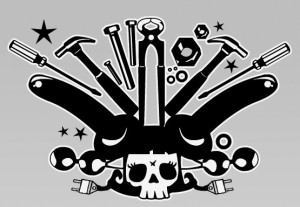
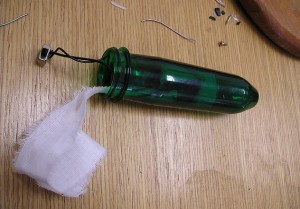 Opposing the idea of “virtual feminism”, BS was trying to recover the body and to go back to an analog reality without giving up on technology.
Opposing the idea of “virtual feminism”, BS was trying to recover the body and to go back to an analog reality without giving up on technology.
——
This project was supported by local authorities and public institutions. However when their representatives saw the end result of the workshop they were shocked and scandalised. They argued that this had nothing to do with art.
¿is this Art?
Art is an independent domain that is constantly loosing its boundaries, but the common perception is still very conservative.
We can read this project under the concept of Relational Aesthetic, a term used by Nicolas Bourriaud to refer a set of artistic practices which take, as point of departure, human relations and their social context rather than an independent and elitist space.
But this project is mainly based on the legacy of Neoconcrete artists, Helio Oiticica and Lygia Clark. Although not technologically based, Clark’s and Oiticica’s works were including interactivity in art. They made glasses, hoods, masks, gloves, capes and created immersive environments which can be seen as early virtual- reality experiments from the 1960s and 1970s.
Also I would like to mention CADA, a Collective of artists in Chile between the period of 1977 y 1983 . A group of interdisciplinary visual artists, poets and writers used magazines, public spaces, and marginalized territories to create new meanings into daily life. They worked within the context of the military dictatorship and the resulting difficult economic and political environment.
In conclusion, SB could be seen as a good example where artistic practices are not confined to the exclusive sphere of passive contemplation, or the mere illusion of interactivity given in any piece of new media art.
Instead they use in an alternative way the body, and technology in order to re-write its meanings.

